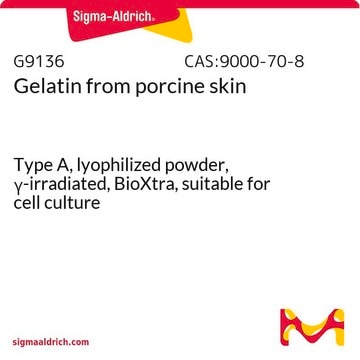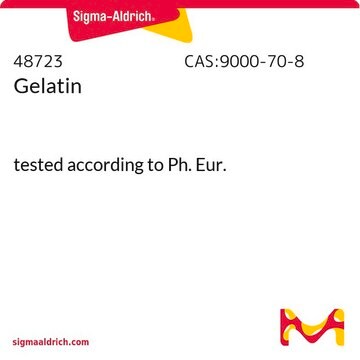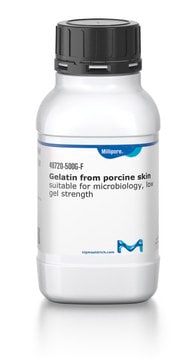G9391
Bovine Gelatin
from bovine skin, Type B, powder, suitable for cell culture
About This Item
Produits recommandés
product name
Gelatin from bovine skin, Type B, powder, BioReagent, suitable for cell culture
Source biologique
bovine skin
Stérilité
sterile
Type
Type B
Gamme de produits
BioReagent
Forme
powder
Conditionnement
pkg of 100 g
pkg of 500 g
Technique(s)
cell culture | mammalian: suitable
Résistance du gel
~225 g Bloom
Solubilité
H2O: soluble 50 mg/mL, hazy to strongly hazy, faintly yellow to yellow
Conditions d'expédition
ambient
Température de stockage
room temp
Vous recherchez des produits similaires ? Visite Guide de comparaison des produits
Catégories apparentées
Description générale
Application
- in coating cell culture to improve attachment of cells,
- in PCR to stabilize Taq DNA, as a blocking reagent in Western blotting, ELISA, and immunochemistry,
- as a component of media for species differentiation in bacteriology
- as a biocompatible polymer
- as a delivery vehicle for the release of active biomolecules
- in the generation of scaffolds for tissue engineering applications.
- to study long-chain fatty acid-induced changes in gene expression in neonatal cardiac monocytes
- to study to test mobilization of capillary endothelium in-vitro induced by effectors of angiogenesis in vivo
Actions biochimiques/physiologiques
Composants
Attention
Notes préparatoires
Code de la classe de stockage
11 - Combustible Solids
Classe de danger pour l'eau (WGK)
nwg
Point d'éclair (°F)
Not applicable
Point d'éclair (°C)
Not applicable
Équipement de protection individuelle
Eyeshields, Gloves, type N95 (US)
Certificats d'analyse (COA)
Recherchez un Certificats d'analyse (COA) en saisissant le numéro de lot du produit. Les numéros de lot figurent sur l'étiquette du produit après les mots "Lot" ou "Batch".
Déjà en possession de ce produit ?
Retrouvez la documentation relative aux produits que vous avez récemment achetés dans la Bibliothèque de documents.
Les clients ont également consulté
Articles
The extracellular matrix (ECM) and its attachment factor components are discussed in this article in relation to their function in structural biology and their availability for in vitro applications.
The extracellular matrix (ECM) is secreted by cells and surrounds them in tissues.
Cancer stem cell media, spheroid plates and cancer stem cell markers to culture and characterize CSC populations.
Protocoles
This gelatin coating protocol for cell culture applications offers information regarding types of gelatin, surface coverage concentration, and tips for optimization.
Notre équipe de scientifiques dispose d'une expérience dans tous les secteurs de la recherche, notamment en sciences de la vie, science des matériaux, synthèse chimique, chromatographie, analyse et dans de nombreux autres domaines..
Contacter notre Service technique















